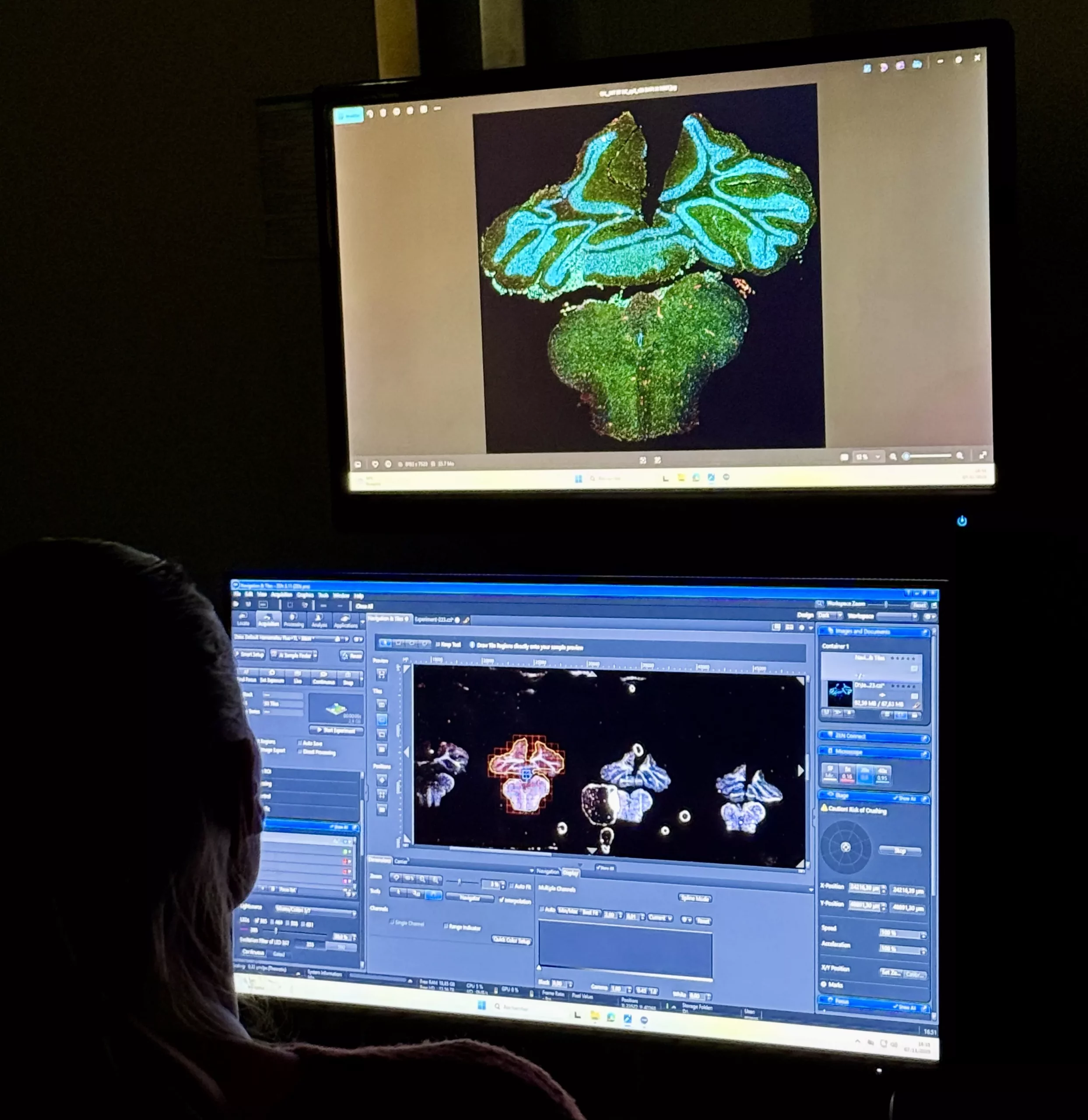The Centre Scientifique de Monaco (CSM) has acquired a cutting-edge robotic microscope that promises to transform how scientists study childhood brain tumours. The €150,000 investment — made possible thanks to the association Enfants Cancers Santé, with additional support from the Pagani Association and CFM Indosuez — was officially unveiled on Friday 7th November.
The funding has enabled the CSM to purchase a fully automated, motorised video microscope along with advanced image analysis software. The technology will allow researchers to analyse tumours in extraordinary detail, helping to unlock a deeper understanding of how childhood brain cancers develop and evolve — and ultimately, how to treat them more effectively.
“What really changes things for us is being able to capture very high-resolution images of very large samples,” Dr Vincent Picco, head of the Brain Stem Cells and Tumours team at the CSM, told Monaco Life. “We now get both a global view of what’s happening — we work on brain cancers, so we can see the tumour as a whole — and, at the same time, a detailed view of that same sample. This simply wouldn’t be possible without this type of robotic microscope.”
The microscope is fully automated. Once imaging is complete, a computer reconstructs the full image and begins its analysis. This, said Dr Picco, marks a major advance. “We won’t just be able to see things — we’ll be able to quantify them. That’s key, especially now with the rise of artificial intelligence systems.”

The microscope’s advanced capabilities are particularly suited to the lab’s work with fluorescent images, which need to be converted into digital biological data. “The computer helps us detect cells, identify their shape, detect the markers they express… We can now understand the tumour’s architecture thanks to these imaging and image analysis systems,” said Dr Picco. “This kind of technology is now essential in any modern laboratory. So yes, this is a real milestone — to have been able to fund the microscope, largely thanks to donations.”
This level of precision opens up entirely new possibilities for cancer research. By visualising whole tumours in high resolution, scientists can study how cancer cells interact with healthy tissue and observe how different parts of the tumour behave. This is particularly important in paediatric brain cancers, which can be highly heterogeneous — meaning that different regions of the same tumour may respond differently to treatment. Understanding this complexity is key to developing therapies that target the tumour more effectively and with fewer side effects.
In practical terms, the microscope’s ability to generate quantifiable data also speeds up discovery. It allows researchers to train artificial intelligence systems on real tumour images, identify treatment targets more efficiently, and simulate how tumours might react to new drugs or interventions. For children facing aggressive forms of cancer, this means faster translation of research findings into potential therapies — and a more personalised approach to treatment.

Expanding research with two additional programmes
In addition to the microscope, donations to Enfants Cancers Santé have supported two other research programmes at the CSM. The first focuses on radiosensitisation — increasing the sensitivity of tumours to radiotherapy, so lower doses can be used without compromising the effect.
“This is a major challenge in paediatric oncology,” said Dr Picco. “Reducing radiation doses means we can lower the side effects in children. That’s crucial. Some paediatric brain cancers respond very well to treatment, others don’t at all — but even when we achieve remission, we want these children to live long and well. That means fewer long-term side effects from treatment, fewer secondary cancers in adulthood. Unfortunately, those are far too common.”
A guided-missile approach to cancer
The second project, also funded by Enfants Cancers Santé, is being carried out in collaboration with the University of Grenoble-Alpes. It centres on a molecule developed by the university’s radiology lab that Dr Picco describes as a “guided missile”.
“This molecule is injected into the bloodstream and binds specifically to certain tumours on the surface of cancer cells,” he explained. “It can be paired with radioactive elements — either to make the tumour visible using specialist imaging, or to emit high-energy radiation that kills the tumour cells.”
The project is in an advanced clinical phase. GMP-standard batches of the molecule have already been produced for laboratory testing, with the goal of moving into clinical trials for adult glioblastomas, and potentially paediatric medulloblastomas — a form of cerebellum tumour — in the near future. “Our lab’s work, along with that of our colleagues in Grenoble, has shown that this approach could be relevant in paediatric brain tumours too,” said Dr Picco.
Monaco’s commitment to paediatric oncology
Much of this focus on childhood cancers can be traced back to the early involvement of Fondation Flavien, an association that has supported the CSM for many years. “They were the ones who originally steered the lab toward paediatric oncology,” said Dr Picco. “Before, our teams worked mostly on adult cancers. But Fondation Flavien and its president, Makarios, came to us and said: ‘We want to fund cancer research in the Principality, but specifically in paediatric oncology.’”
That early support helped reshape the direction of cancer research at the CSM. Today, the centre is not only focused on fundamental science but is actively involved in clinical trials. One such trial, referred to as the MEPENDAX clinical trial project and based in Marseille, is already underway and is partially funded by Fondation Flavien, the French government and other institutional and private partners.
As new tools like the robotic microscope come online, and with ongoing support from local based organisations, the CSM can continue to play an increasingly important role in tackling childhood brain cancer.
See also:
Stay updated with Monaco Life: sign up for our free newsletter, catch our podcast on Spotify, and follow us across Facebook, Instagram, LinkedIn, and Tik Tok.
Main photo credit: Cassandra Tanti, Monaco Life
